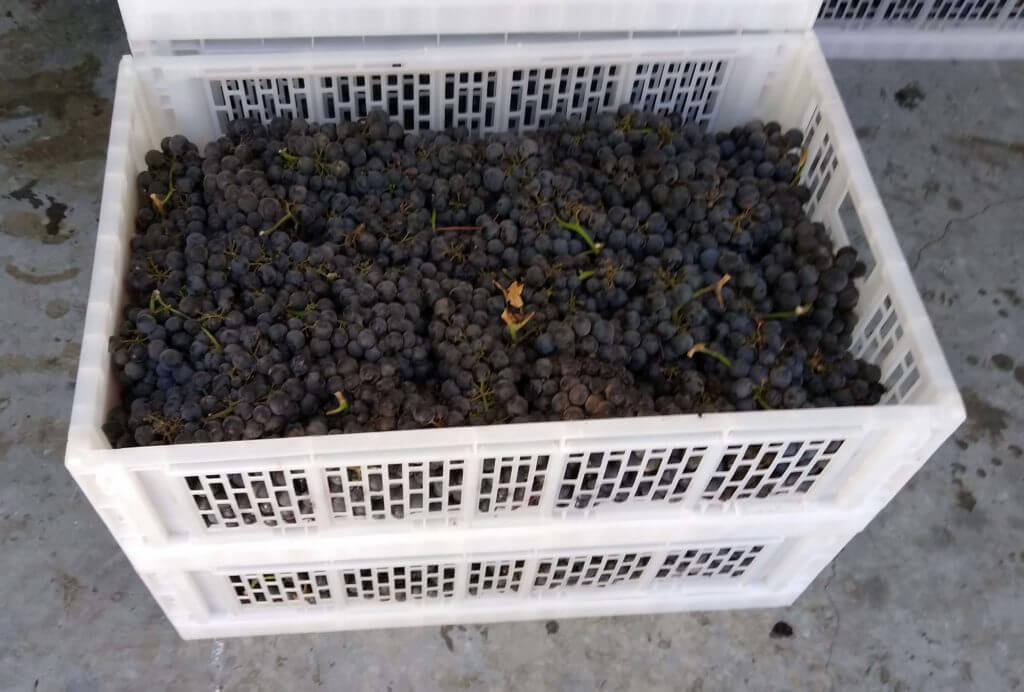Winemaking 101 – Episode 2 – The Crush
Welcome to the second installment of Winemaking 101! Today’s post describes the crush, what it is, and why we do it.
What is crushing? It’s crushing the grapes to let the juice out. [Yeah, that was hard to figure out!]
Typically this is performed using a crusher/destemmer, which not only crushes the grapes, it extracts the stems and collects them for disposal. The stems can add bitterness and off-flavors, so in most cases they are discarded before fermentation.
Our group’s organizer has a home-size crusher/destemmer — a small one, it handled 4 tons of grapes in less than 3 hours, and we were not really efficient. Commercial units run up to $50,000 USD and can process 70-80 tons per hours [a bit of overkill for our needs.]

Grapes go in the hopper, a screw pushes them to the right where rotating baffles crush the grapes and pull them from the stems. The grape pulp drops on the wide-holed screen (standing outside the machine in the picture) and another screw pushes the pulp and stems along the screen. The pulp drops through and the stems kick out the end.
I brought my crusher along, in case the organizer’s machine wasn’t up to the task. His is rated for 1.78 tons per hour. Mine is rated for 85 lbs per hour. [Wine making joke, normal people may not appreciate it.]

A lot of the folks were interested in my little one — they’d never seen anything like it.
Once we got rolling, we used a stack of pallets as the staging table. We collected the lugs of grapes for the current person and started running them through the machine.

Sadly, the lugs themselves get thrown out. It’s a lot of waste going into the land fill.

People handled their grapes in different ways. Some people had multiple grape varieties and crushed them all together. Their “blend” was everything.
Most separated their grapes by variety. One person had 30+ Home Depot orange buckets (which are #4 plastic, food safe for transport and fermentation), each lined with a mesh bag. He crushed each lug and put in a separate bucket, then snapped the lid on. When fermentation is done, he lifts the bag out and drops it in the press. It’s a really interesting idea as each bucket is easy to handle (36 lbs + the bucket), and it makes pressing simple.
The downside? He has 30+ buckets to deal with.
This is the crusher in action:

We collected the stems in outdoor sized trash bags. Eight tons of grapes produced 9 very full bags of stems.

I purchased 5 lugs each of Zinfandel, Malbec, and Merlot — I put each into a separate container. Two are food grade barrels I was given, and the third is a Rubbermaid Brute 32 gallon garbage can (#4 food grade plastic). The barrels are perfect for transport — the lid locks on and is spill proof. But they are tall and narrow, making it harder to take care of the fermenting wine. It’s a trade-off.
At 180 lbs each, the containers are not easy to manipulate, although the Brute is easier because it has handles.. Four of us lifted them into my truck. I secured them with tie-down strapes and put a cargo net over everything.

My friend John and I got them off the truck — we had gravity on our side. Lorraine purchased a small, flat cart, and we put the containers on that to move them into the cellar.
The grapes were cold so I had to wait until the next day (Sunday) to inoculate with yeast.
One funny thing happened. I had a 20 gallon Brute I purchased in 1989. It’s been in my attic for years, along with another fermenter. The other one crackled when I flexed it, so while I brought it along, I didn’t think using it was wise. The old Brute seemed perfectly fine and I brought it, but again, I was leery.
So I put my grapes into the 2 blue barrels and 1 Brute — I didn’t need the second one, nor did I need my old fermenters. [Always bring more capacity than you need — better too much than too little!]
I dropped the 20 gallon Brute into the 32 gallon for transport, a distance of 2 feet.
It exploded!
Maybe it’s more accurate to say it shattered, but it looked like an explosion. I’m quite happy I didn’t try to use it.

Stay tuned for Winemaking 101 — Episode 3!
